1998 CHEVROLET CORVETTE engine
[x] Cancel search: enginePage 329 of 378
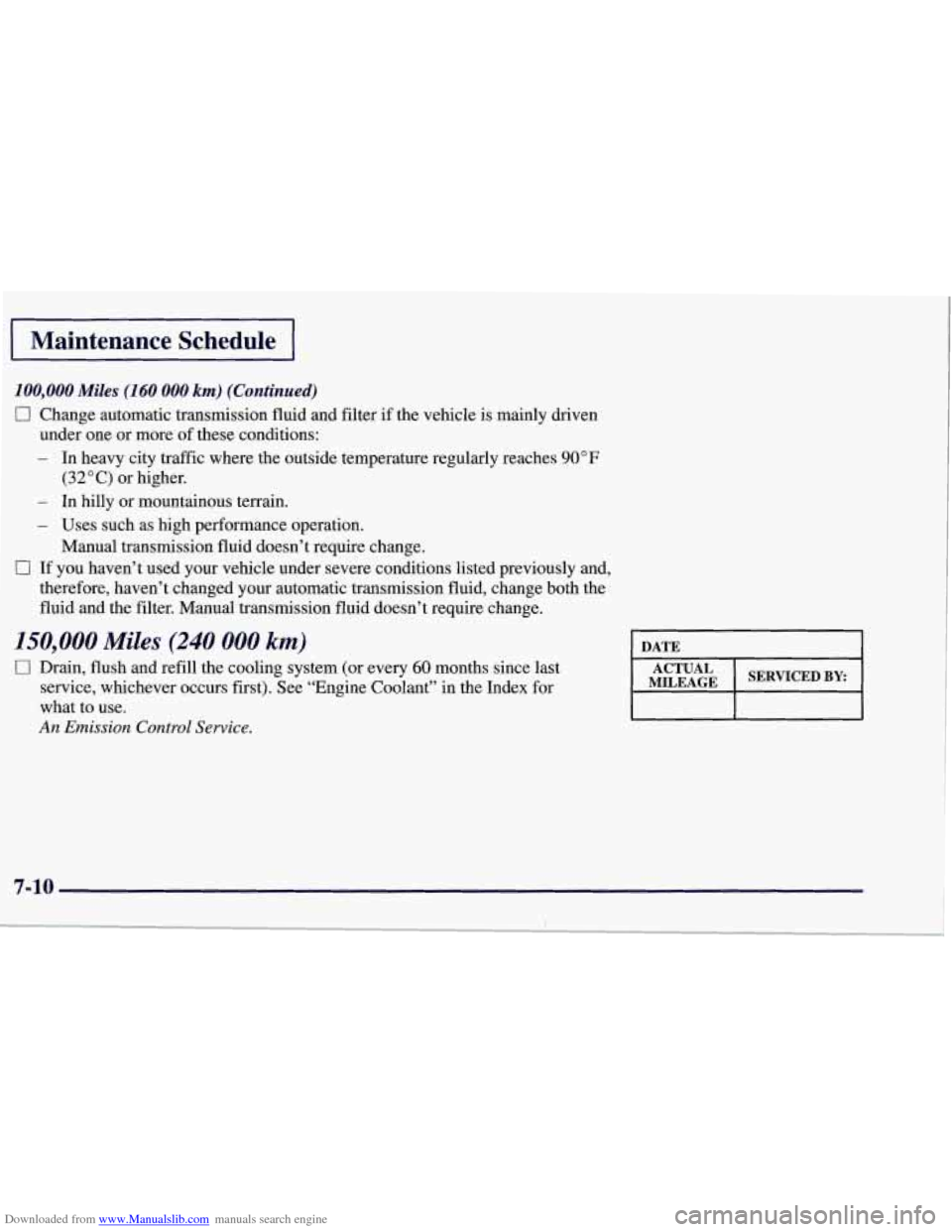
Downloaded from www.Manualslib.com manuals search engine Maintenance Schedule
100,000 Miles (160 000 km) (Continued)
0 Change automatic transmission fluid and filter if the vehicle is mainly driven
under one or more of these conditions:
- In heavy city traffic where the outside temperature regularly reaches 90°F
(32 O C) or higher.
- In hilly or mountainous terrain.
- Uses such as high performance operation.
Manual transmission fluid doesn’t require change.
0 If you haven’t used your vehicle under severe conditions listed previously and,
therefore, haven’t changed your automatic transmission fluid, change
both the
fluid and the filter. Manual transmission fluid doesn’t require change.
150,000 Miles (240 000 km)
0 Drain, flush and refill the cooling system (or every 60 months since last
service, whichever occurs first). See “Engine Coolant” in the Index for
what to use.
An Emission Control Sewice.
DATE I
MILEAGE
7-10
I
Page 330 of 378
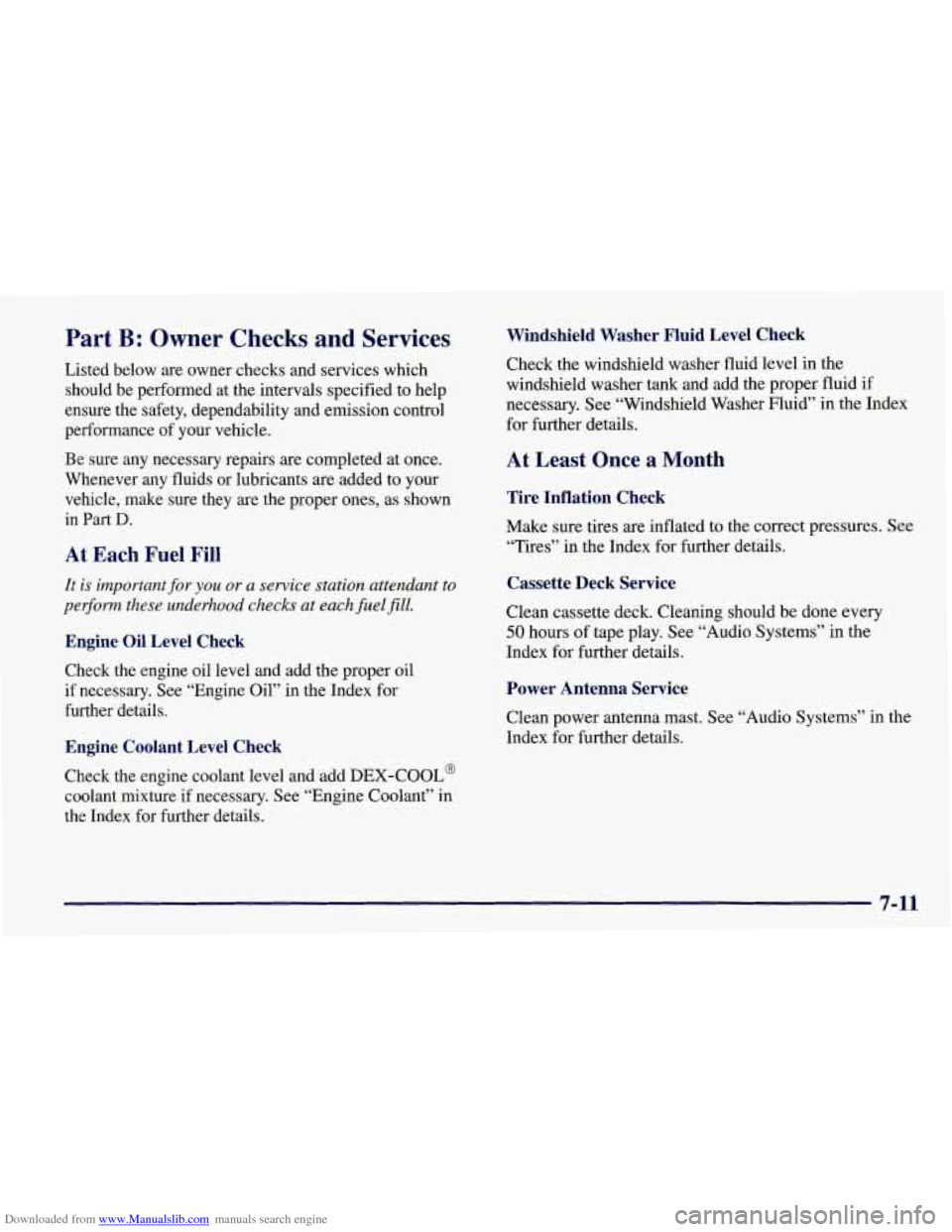
Downloaded from www.Manualslib.com manuals search engine Part B: Owner Checks and Services
Listed below are owner checks and services which
should be performed at the intervals specified to help
ensure the safety, dependability and emission control
performance of your vehicle.
Be sure any necessary repairs are completed at once.
Whenever any fluids or lubricants are added to your
vehicle, make sure they
are the proper ones, as shown
in
Part D.
At Each Fuel Fill
It is important for you or a service station attendant to
pe$om these underhood checks at each fuel
fill.
Engine Oil Level Check
Check the engine oil level and add the proper oil
if necessary. See “Engine Oil” in the Index for
further details.
Engine Coolant Level Check
Check the engine coolant level and add DEX-COOL@
coolant mixture
if necessary. See “Engine Coolant” in
the Index for further details.
Windshield Washer Fluid Level Check
Check the windshield washer fluid level in the
windshield washer tank and add the proper fluid if
necessary.
See “Windshield Washer Fluid” in the Index
for further details.
At Least Once a Month
Tire Inflation Check
Make sure tires are inflated to the correct pressures. See
“Tires” in the Index for further details.
Cassette Deck Service
Clean cassette deck. Cleaning should be done every
50 hours of tape play. See “Audio Systems” in the
Index for further details.
Power Antenna Service
Clean power antenna mast. See “Audio Systems” in the
Index for further details.
7-11
Page 331 of 378
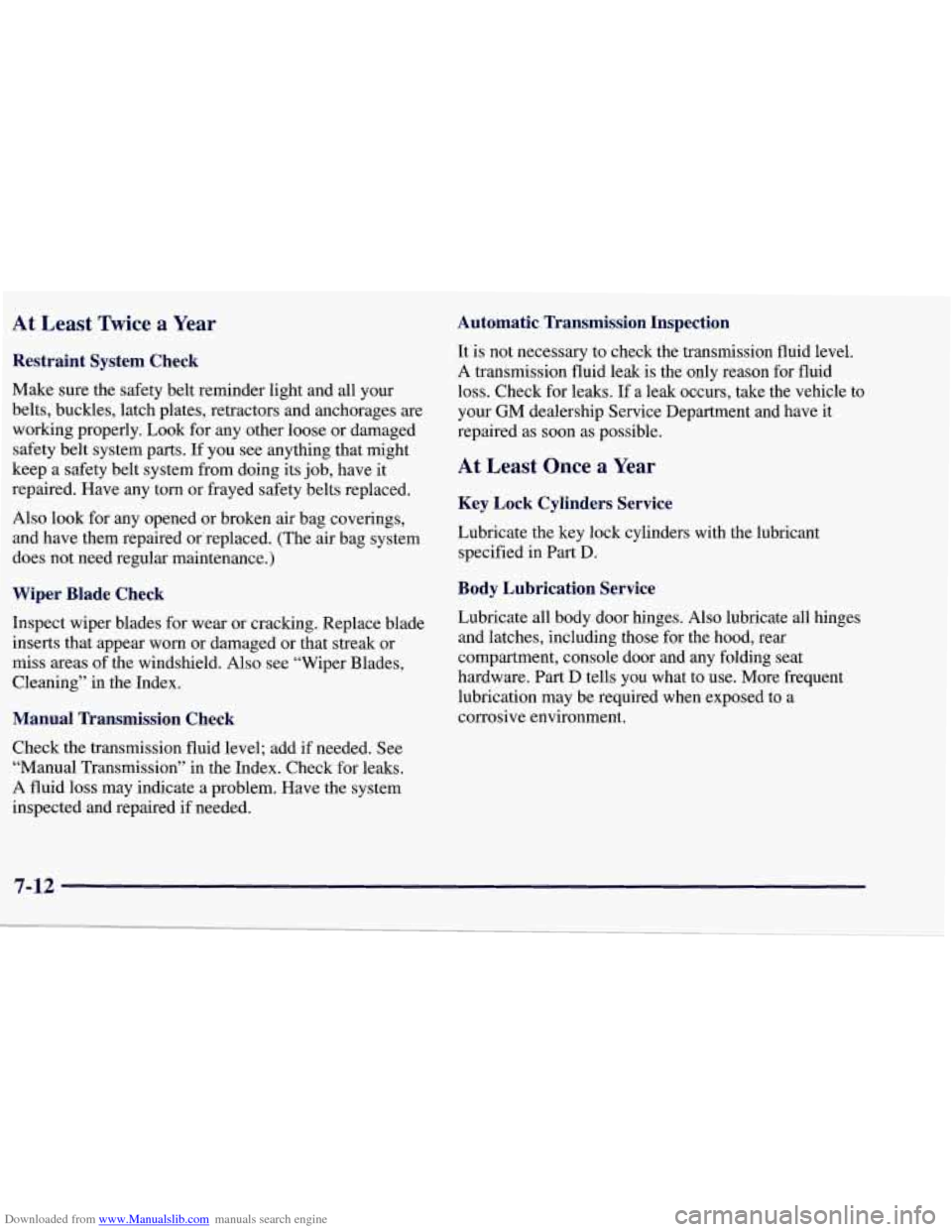
Downloaded from www.Manualslib.com manuals search engine At Least Twice a Year Automatic Transmission Inspection
Restraint System Check
Make sure the safety belt reminder light and all your
belts, buckles, latch plates, retractors and anchorages are
working properly. Look for any other loose or damaged
safety belt system parts. If you see anything that might
keep a safety belt system from doing its job, have it
repaired. Have any torn or frayed safety belts replaced.
Also look for any opened or broken
air bag coverings,
and have them repaired or’replaced. (The air bag system
does not need regular maintenance.)
Wiper Blade Check
Inspect wiper blades for wear or cracking. Replace blade
inserts that appear
worn or damaged or that streak or
miss areas of the windshield. Also see “Wiper Blades.
Cleaning” in the Index.
Manual Transmission Check
Check the transmission fluid level; add if needed. See
“Manual Transmission” in the Index. Check for leaks.
A fluid loss may indicate a problem. Have the system
inspected and repaired
if needed. It is
not necessary to check the transmission fluid level.
A transmission fluid leak is the only reason for fluid
loss. Check for leaks.
If a leak occurs, take the vehicle to
your
GM dealership Service Department and have it
repaired as
soon as possible.
At Least Once a Year
Key Lock Cylinders Service
Lubricate the key lock cylinders with the lubricant
specified in Part D.
Body Lubrication Service
Lubricate all body door hinges. Also lubricate all hinges
and latches, including those for the hood, rear
compartment, console door and any folding seat
hardware.
Part D tells you what to use. More frequent
lubrication may be required when exposed to a
corrosive environment.
Page 332 of 378
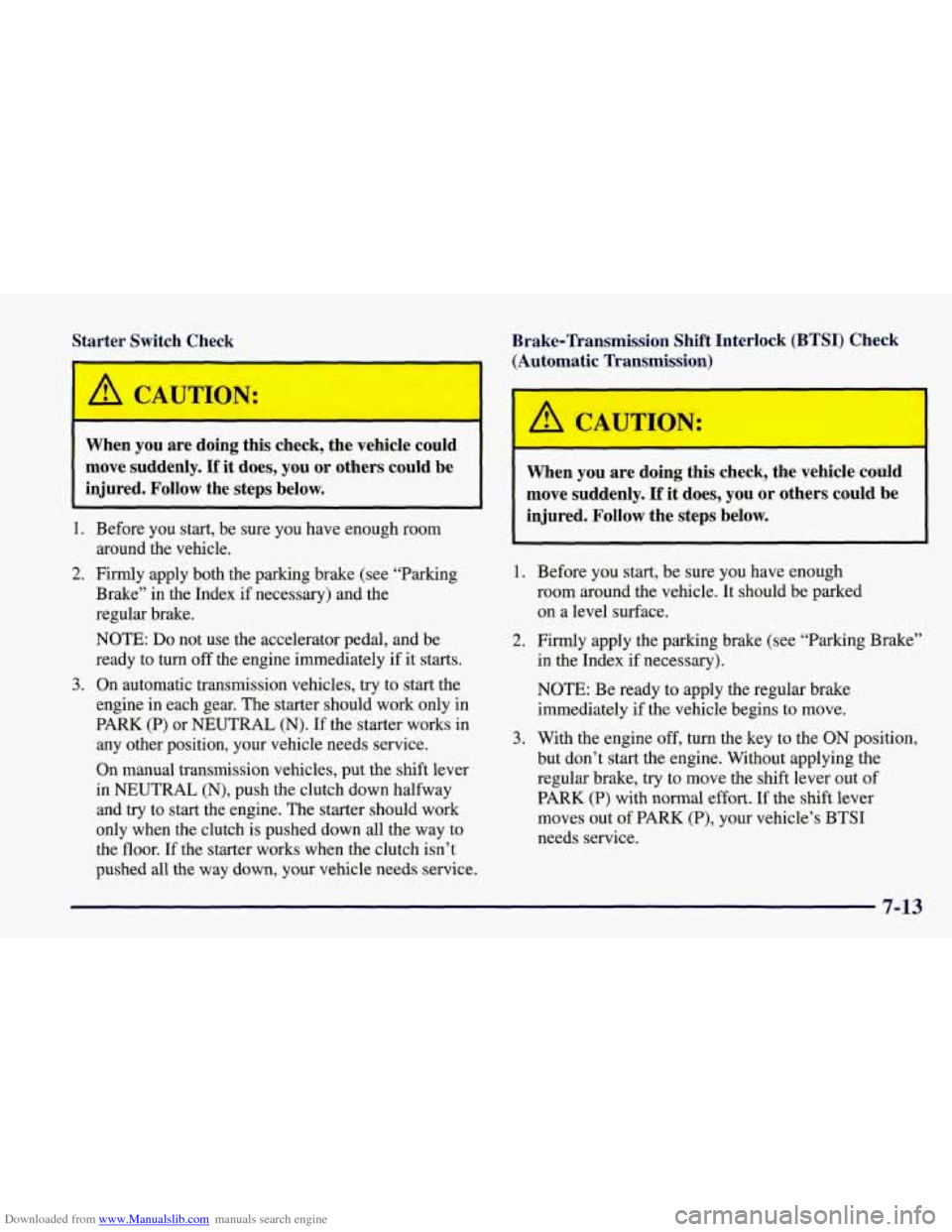
Downloaded from www.Manualslib.com manuals search engine Starter Switch Check
-
I A CAUTION:
Brake-Transmission Shift Interlock (BTSI) Check (Automatic Transmission)
When you are doing this check, the vehicle could
move suddenly.
If it does, you or others could be
injured. Follow the steps below.
1. Before you start, be sure you have enough room
2. Firmly apply both the parking brake (see “Parking
around the vehicle.
Brake” in the Index if necessary) and the
regular brake.
NOTE:
Do not use the accelerator pedal, and be
ready to turn off the engine immediately if it starts.
3. On automatic transmission vehicles, try to start the
engine in each gear. The starter should work only in
PARK (P) or NEUTRAL (N). If the starter works in
any other position, your vehicle needs service.
On manual transmission vehicles, put the shift lever
in NEUTRAL (N), push the clutch down halfway
and try to start the engine. The starter should work
only when the clutch is pushed down all the way to
the floor.
If the starter works when the clutch isn’t
pushed all the way down, your vehicle needs service.
I A CAUTION:
I
When you are doing this check, the vehicle could
move suddenly.
If it does, you or others could be
injured. Follow the steps below.
1. Before you start, be sure you have enough
room around the vehicle. It should be parked
on a level surface.
2. Firmly apply the parking brake (see “Parking Brake”
in the Index if necessary).
NOTE: Be ready to apply the regular brake
immediately if the vehicle begins to move.
3. With the engine off, turn the key to the ON position,
but don’t start the engine. Without applying the
regular brake, try to move the shift lever out of
PARK (P) with normal
effort. If the shift lever
moves out of PARK (P), your vehicle’s BTSI
needs service.
7-13
Page 333 of 378

Downloaded from www.Manualslib.com manuals search engine Ignition Automatic Transmission Lock Check
While parked, and with the parking brake set, try to turn
the ignition key to
OFF in each shift lever position. The
key should turn to
OFF only when the shift lever is in
PARK (P).
On all vehicles, the key should come out only in
OFF.
Parking Brake and Automatic Transmission
PARK
(P) Mechanism Check
When you are doing this check, your vehicle
could begin to move. You
or others could be
injured and property could be damaged. Make sure there
is room in front of your vehicle in case
it begins to roll. Be ready to apply the regular
brake
at once should the vehicle begin to move. Park on
a fairly steep hill, with the vehicle facing
downhill. Keeping your foot on the regular brake,
set the parking brake.
0 To check the parking brake’s holding ability: With
the engine running and transmission in
NEUTRAL (N), slowly remove foot pressure from
the regular brake pedal.
Do this until the vehicle is
held by the parking brake only.
To check the PARK (P) mechanism’s holding ability:
With the engine running, shift to PARK (P). Then
release all brakes.
Underbody Flushing Service
At least every spring, use plain water to
flush any
corrosive materials from the underbody. Take care to
clean thoroughly any areas where mud and other debris
can collect.
Page 334 of 378
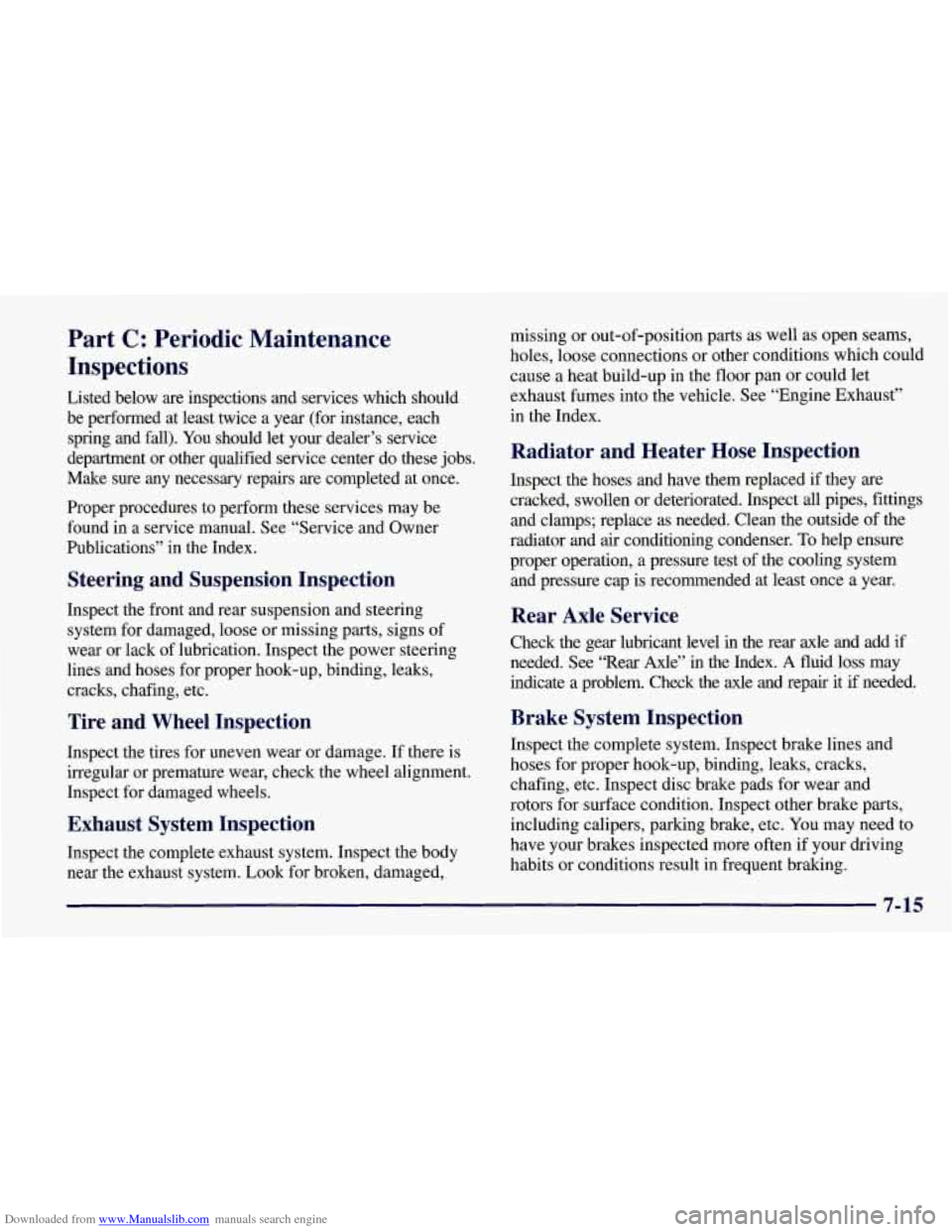
Downloaded from www.Manualslib.com manuals search engine Part C: Periodic Maintenance
Inspections
Listed below are inspections and services which should
be performed at least twice a year (for instance, each spring and fall).
You should let your dealer’s service
department or other qualified service center do these jobs.
Make sure any necessary repairs are completed at once.
Proper procedures to perform these services may be
found in a service manual. See “Service and Owner
Publications” in the Index.
Steering and Suspension Inspection
Inspect the front and rear suspension and steering
system for damaged, loose or missing parts, signs of
wear or lack of lubrication. Inspect the power steering
lines and hoses for proper hook-up, binding, leaks,
cracks, chafing, etc.
Tire and Wheel Inspection
Inspect the tires for uneven wear or damage. If there is
irregular or premature wear, check the wheel alignment.
Inspect for damaged wheels.
Exhaust System Inspection
Inspect the complete exhaust system. Inspect the body
near the exhaust system. Look for broken, damaged, missing
or out-of-position parts as well as open seams,
holes, loose connections or other conditions which could
cause a heat build-up in the floor pan or could let
exhaust fumes into the vehicle. See “Engine Exhaust”
in the Index.
Radiator and Heater Hose Inspection
Inspect the hoses and have them replaced if they are
cracked, swollen or deteriorated. Inspect all pipes, fittings
and clamps; replace as needed. Clean the outside of the
radiator and air conditioning condenser.
To help ensure
proper operation, a pressure test of the cooling system
and pressure cap is recommended at least once a year.
Rear Axle Service
Check the gear lubricant level in the rear axle and add if
needed. See “Rear Axle” in the Index.
A fluid loss may
indicate a problem. Check the axle and repair it
if needed.
Brake System Inspection
Inspect the complete system. Inspect brake lines and
hoses for proper hook-up, binding, leaks, cracks,
chafing, etc. Inspect disc brake pads for wear and
rotors for surface condition. Inspect other brake parts,
including calipers, parlung brake, etc. You may need to
have your brakes inspected more often if your driving
habits or conditions result in frequent braking.
7-15
Page 335 of 378
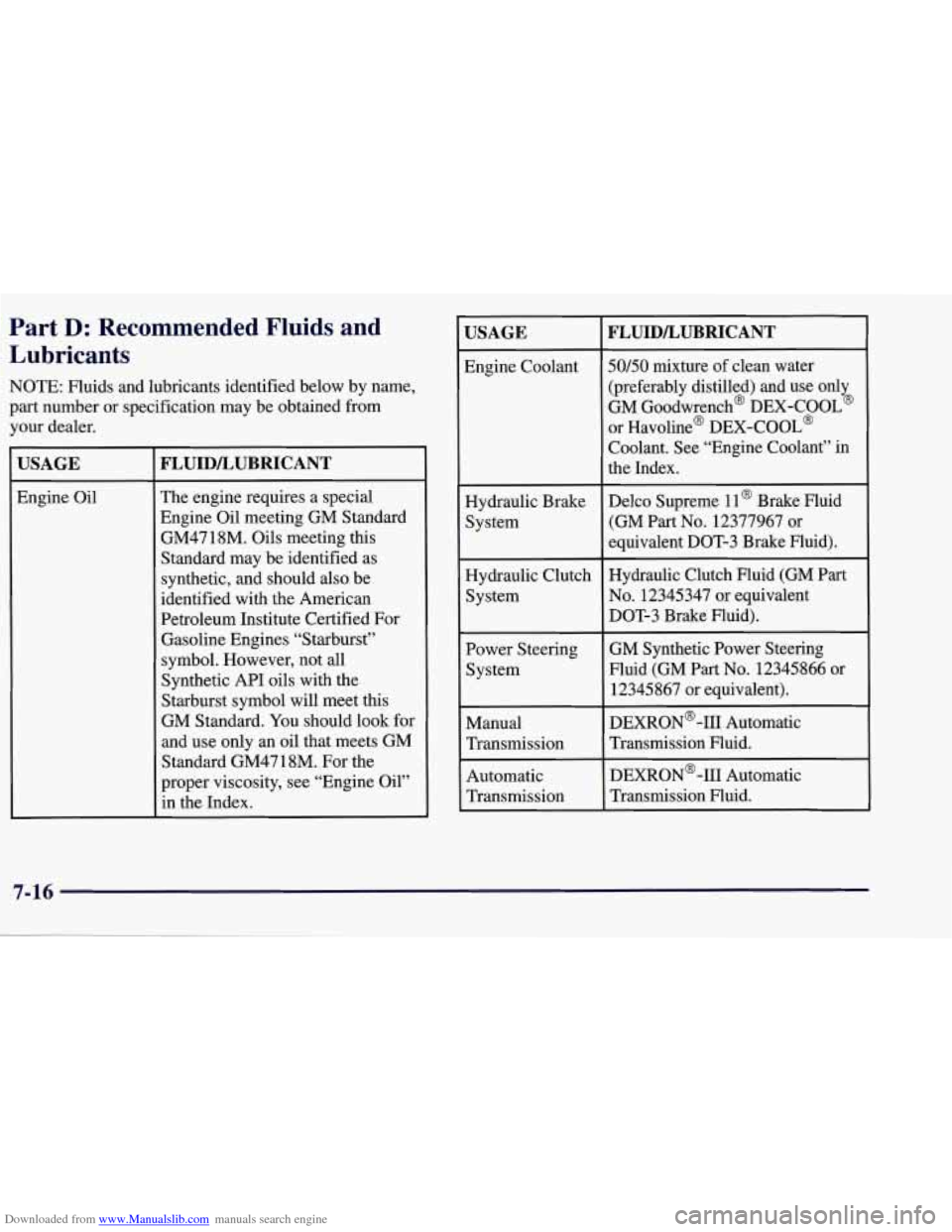
Downloaded from www.Manualslib.com manuals search engine Part D: Recommended Fluids and
Lubricants
NOTE: Fluids and lubricants identified below by name,
part number
or specification may be obtained from
your dealer.
USAGE
Engine Oil
FLUIDLUBRICANT
The engine requires a special
Engine Oil meeting GM Standard
GM4718M. Oils meeting this
Standard may be identified as
synthetic, and should
also be
identified with the American
Petroleum Institute Certified For Gasoline Engines “Starburst” symbol. However, not all
Synthetic API oils with the
Starburst symbol will meet this
GM Standard. You should look for
and use only an oil that meets GM
Standard GM47 18M. For the
proper viscosity, see “Engine Oil”
in the Index.
USAGE ~~
Engine Coolant
Hydraulic Brake
System
Hydraulic Clutch System
~
Power Steering System
Manual Transmission
Automatic Transmission
FLUIDLUBRICANT
50/50 mixture of clean water
(preferably distilled) and use only
GM Goodwrench@ DEX-COOL@
or Havoline@ DEX-COOL@
Coolant. See “Engine Coolant” in
the Index.
Delco Supreme
11 @ Brake Fluid
(GM Part No. 12377967
or
equivalent DOT-3 Brake Fluid).
Hydraulic Clutch Fluid (GM Part
No. 12345347 or equivalent
DOT-3 Brake Fluid).
GM Synthetic Power Steering
Fluid
(GM Part No. 12345866 or
12345867 or equivalent).
DEXRON@-I11 Automatic
Transmission Fluid. DEXRON@
-111 Automatic
Transmission Fluid.
Page 336 of 378

Downloaded from www.Manualslib.com manuals search engine USAGE
Key Lock
Cylinders
Rear Axle
(Limited-Slip
Differential)
Windshield Washer Solvent
FLUIDLUBRICANT
Multi-Pu ose Lubricant,
Superlube
% (GM Part
No. 12346241 or equivalent).
Axle Lubricant (GM Part
No. 12345977) and 4 ounces
(1 18 ml) of Limited-Slip
Differential Lubricant Additive
(GM Part
No. 1052358 or
equivalent) where required. See “Rear Axle” in the Index.
GM Optikleen@ Washer Solvent
(GM Part
No. 1051515) or
equivalent.
USAGE
Hood Latch
Assembly,
Pivots, Spring
Anchor and
Release Pawl
Hood and Door
Hinges
-
Weatherstrip Conditioning
FLUIDLUBRICANT
Lubriplate Lubricant Aerosol (GM
Part
No. 12346293 or equivalent)
or lubricant meeting requirements
of NLGI
# 2, Category LB or
GC-LB.
Multi-Pu ose Lubricant,
Superlube
% (GM Part
No. 12346241 or equivalent).
Dielectric Silicone Grease (GM
Part
No. 12345579 or equivalent).
7-17